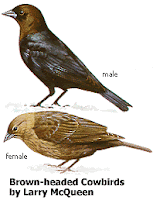An unusual visitor
At one of the bird feeders outside my study window early yesterday morning, I saw two visitors that weren’t usual at all. The dark black bird with the brown head that caught my eye turned out to be a male cowbird, but I didn’t recognize the other. Doing a bit of investigation (that is, checking out my ID in one of the many bird books that I have), and after noticing that they flew up into the oak tree together, I realized that the other bird was a female cowbird – a drab light brown bird, with streaky feathers. Since cowbirds are brood parasites, laying eggs in other species' nests for them to raise, it's hard to feel too warm or fuzzy about them, but they're interesting birds, nevertheless. Their range greatly expanded east following waves of forest clearing, as they're birds of open areas and edges, originally native to the Great Plains.
 They normally forage on the ground, eating seeds and insects, but must have figured the seed mix in the feeder was worth checking out. They often are parts of blackbird foraging 'flocks' in spring, as they move towards their breeding grounds.
They normally forage on the ground, eating seeds and insects, but must have figured the seed mix in the feeder was worth checking out. They often are parts of blackbird foraging 'flocks' in spring, as they move towards their breeding grounds.
These illustrations of a male and female cowbird are from birds.cornell.edu. Here's some more information about cowbirds on All About Birds, on Cornell Lab of Ornithology's website. Hilton Pond had a nice piece, too, last spring describing cowbird behavior in York, SC.
 They normally forage on the ground, eating seeds and insects, but must have figured the seed mix in the feeder was worth checking out. They often are parts of blackbird foraging 'flocks' in spring, as they move towards their breeding grounds.
They normally forage on the ground, eating seeds and insects, but must have figured the seed mix in the feeder was worth checking out. They often are parts of blackbird foraging 'flocks' in spring, as they move towards their breeding grounds.These illustrations of a male and female cowbird are from birds.cornell.edu. Here's some more information about cowbirds on All About Birds, on Cornell Lab of Ornithology's website. Hilton Pond had a nice piece, too, last spring describing cowbird behavior in York, SC.
Comments
Post a Comment
I enjoy hearing from fellow nature lovers and gardeners. Let me know your thoughts.